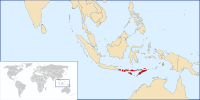Sunda Islands
The Sunda Islands (Indonesian: Kepulauan Sunda; Tetun: Illa Sunda) are a group of islands in the Nusantara (Indonesian Archipelago).[1][2] They consist of the Greater Sunda Islands and the Lesser Sunda Islands.
Etymology
[edit]"Sunda" denotes the continental shelves or landmasses: the Sunda Shelf in the west and the Sahul/Arafuru Shelf in the east. Other terms associated with "Sunda" include the Sunda Island Arc or the arc of Sunda Islands, Sunda Fold or tectonic folding in the Natuna Sea, the Sunda Trench, and Sundaland.[3]
The term "Sunda" has been traced back to ancient times. The name "Sunda" originates from the Sanskrit word "Cuddha," meaning white. During the Pleistocene era, there was a large volcano named Mount Sunda located north of Bandung in West Java. Its eruption covered the surrounding area with white volcanic ash, giving rise to the name "Sunda." The use of the term "Sunda" to refer to the Indonesian region dates back to the claims of Claudius Ptolemaeus in 150 AD. These claims served as a reference for the Portuguese when they arrived in Indonesia in 1500 AD and explored the Sunda kingdom in West Java. They categorized the region into Greater Sunda (Sunda Besar) for the larger western islands and Lesser Sunda (Sunda Kecil) for the smaller eastern islands. Since then, the term "Sunda" has been widely adopted in earth sciences (geology-geography) as a reference for the Indonesian region, surpassing the usage of "Indonesia" in this field. The terms Greater Sunda and Lesser Sunda are commonly used in geological-geographical literature.
Administration
[edit]The Sunda Islands are divided among five countries: Brunei, East Timor, Indonesia, Singapore and Malaysia. The majority of these islands fall under the jurisdiction of Indonesia. Borneo is split among Brunei, Indonesia, and Malaysia. Timor is split between East Timor and Indonesia. Sebatik is split between Indonesia and Malaysia.
List of islands
[edit]- Lesser Sunda Islands (from west to east)
See also
[edit]- Name of Indonesia
- List of islands of Indonesia
- Komodo (island)
- Malay Archipelago
- Sunda Arc
- Sundaland
- Sunda Trench
- Banda Arc
References
[edit]- ^ Raffles, T. S. (1817). "Account of the Sunda Islands and Japan". The Quarterly Journal of Science and the Arts. 2: 190–198.
- ^ Chisholm, Hugh, ed. (1911). "Sunda Islands" . Encyclopædia Britannica. 26 (11th ed.). Cambridge University Press.
- ^ "Berawal dari Gunung Purba, Begini Asal Usul Nama Sunda". Tempo (in Indonesian).
External links
[edit]- Chisholm, Hugh, ed. (1911). . Encyclopædia Britannica. Vol. 26 (11th ed.). Cambridge University Press.
- Visible earth page on the lesser Sunda islands
- (in English and French) Map of a Part of China, the Philippine Islands, the Isles of Sunda, the Moluccas, the Papuans is a map from around 1760 featuring the Sunda Islands
- Historical 1767 Map of the Sunda Islands | Southeast Asia Digital Library


 French
French Deutsch
Deutsch
